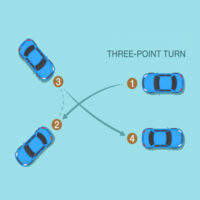Dangers Of Three-Point Turns

Sometimes referred to as K-turns, three-point turns are a common maneuver for changing direction on a road, especially in tight or confined spaces. While this maneuver can be useful, it also carries significant risks, particularly in bustling urban environments like Miami.
There are legal protections in place if you were injured in an accident due to a three-point turn or similar maneuver. Have a conversation with a Miami personal injury lawyer to effectively navigate the insurance negotiations that bubble up in the aftermath of an accident.
When Is a Three-Point Turn Legal in Florida?
A three-point turn must be executed carefully to avoid potential hazards. For instance, a three-point turn should only be performed in areas where visibility is good, and the maneuver will not disrupt traffic. This typically means doing a three-point turn on a quiet residential street or a road with ample space and clear sightlines.
Also drivers must follow all traffic laws and signals when executing a three-point turn. This includes ensuring that the maneuver is made safely without interfering with other vehicles or pedestrians. If there are no signs or signals prohibiting such a turn, and it is safe to perform, a three-point turn is generally permissible. Of course, drivers need to check for approaching vehicles, pedestrians, and potential obstacles before performing any turn.
Situations where three-point turns are not permitted:
- Highways and busy roads. Performing a three-point turn on highways, major roads, or roads with heavy traffic is dangerous and often illegal. The maneuver can create a significant hazard for other drivers and is generally discouraged.
- Near intersections. Executing a three-point turn close to intersections can be problematic. It may confuse other drivers and create potential conflicts with cross traffic.
- Areas with limited space. Trying to perform a three-point turn in areas with limited space, such as narrow streets or parking lots, can increase the risk of collisions and accidents.
Executing a three-point turn can disrupt the normal flow of traffic, particularly if done on busy streets or in areas with high vehicle volume. This can lead to congestion and increased risk of accidents.
Do Unconventional Turns Create Confusion?
Yes, there are situations where other drivers may be unsure of your intentions or may not realize that you are making a three-point turn. This uncertainty can lead to misunderstandings and collisions. Pedestrians may be caught off guard as well. This can lead to dangerous situations where pedestrians are at risk of being struck.
Following an accident caused by a three-point turn or other unconventional maneuver, a skilled Miami personal injury lawyer can help you navigate the legal process and pursue compensation for your injuries and damages. They will gather evidence, such as accident reports, witness statements, and traffic camera footage, to determine fault. Negotiating with insurance companies to ensure you receive fair compensation will happen, too.
Was a three-point turn what prompted your accident injury? The legal team at Spencer Morgan Law is available to fight for your rights. Schedule a confidential consultation today, call 305-423-3800.
